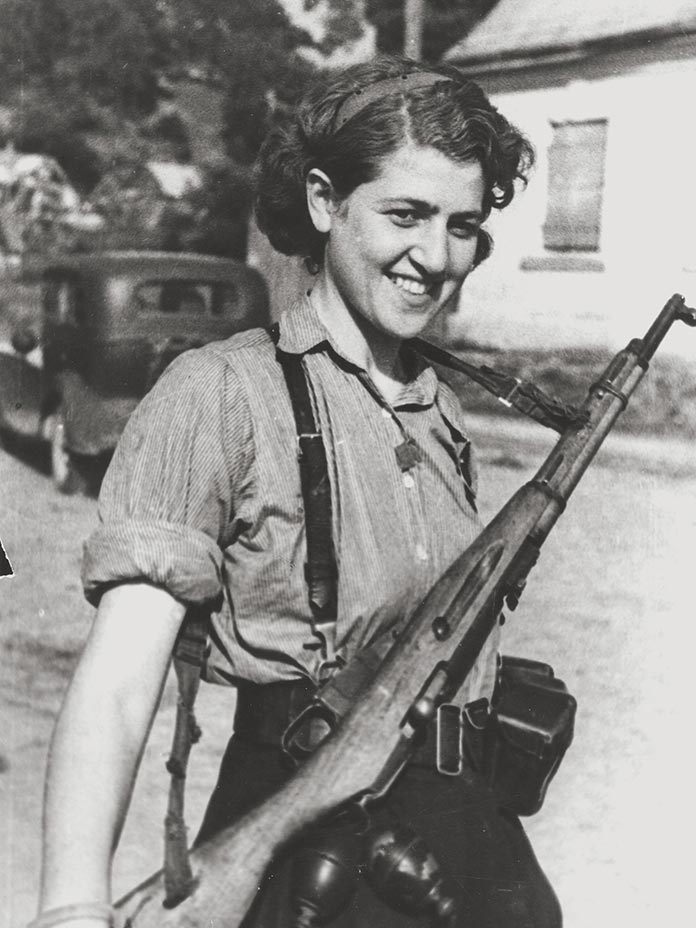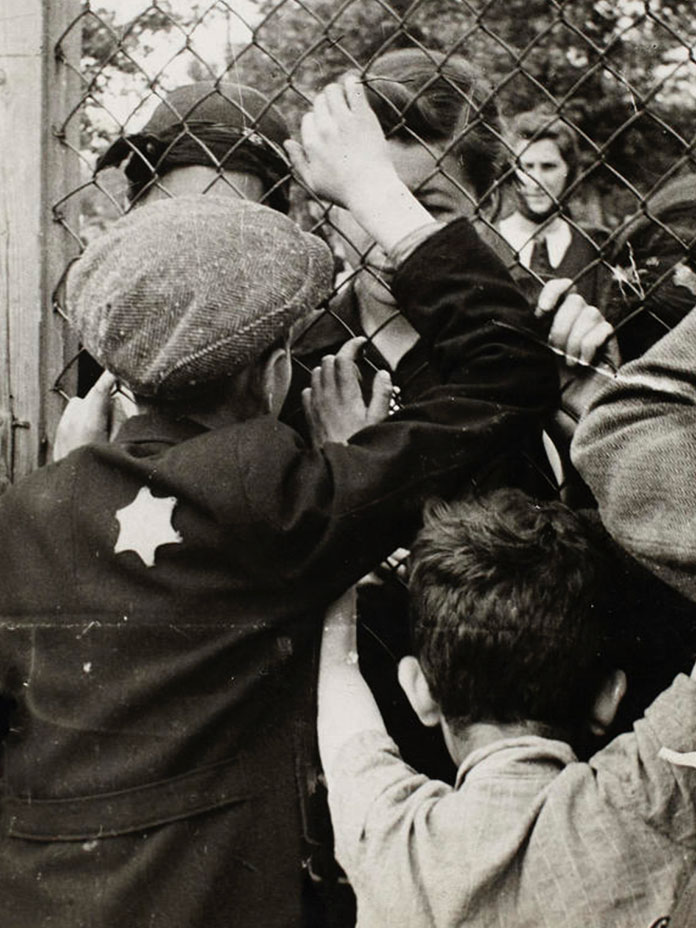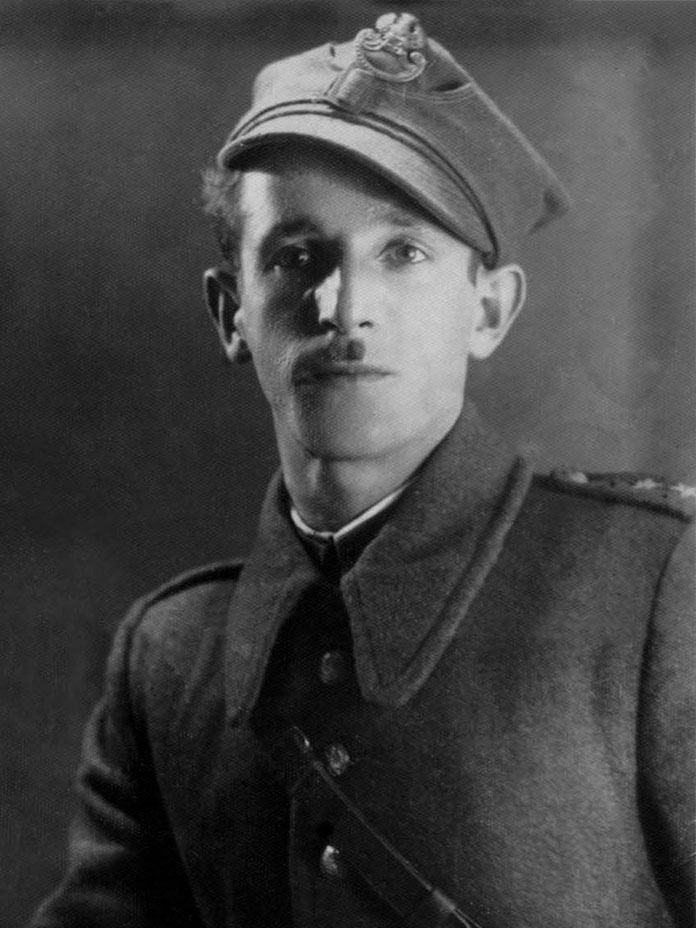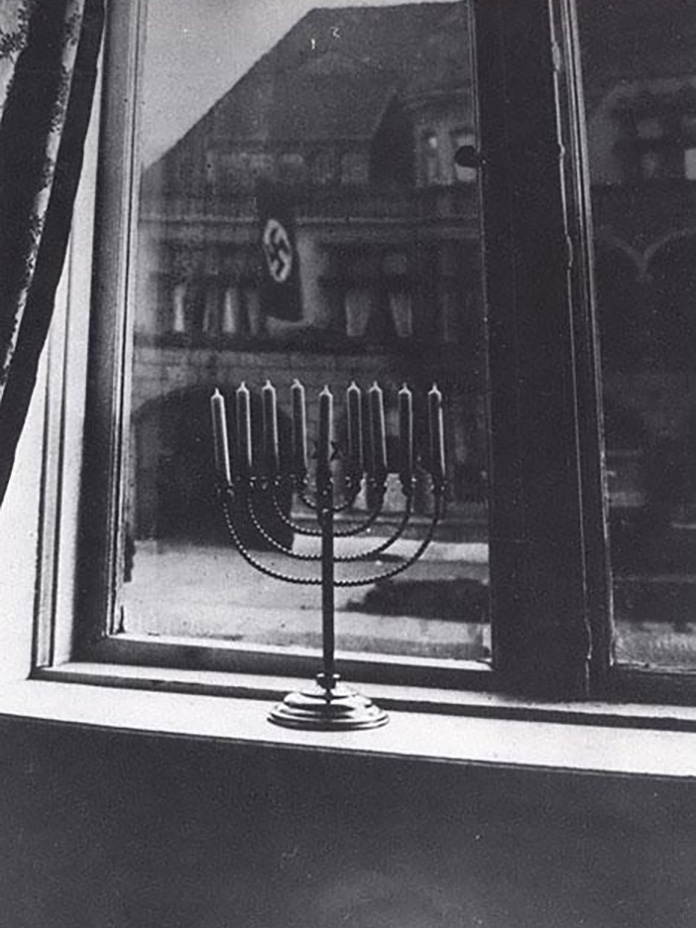Curriculum
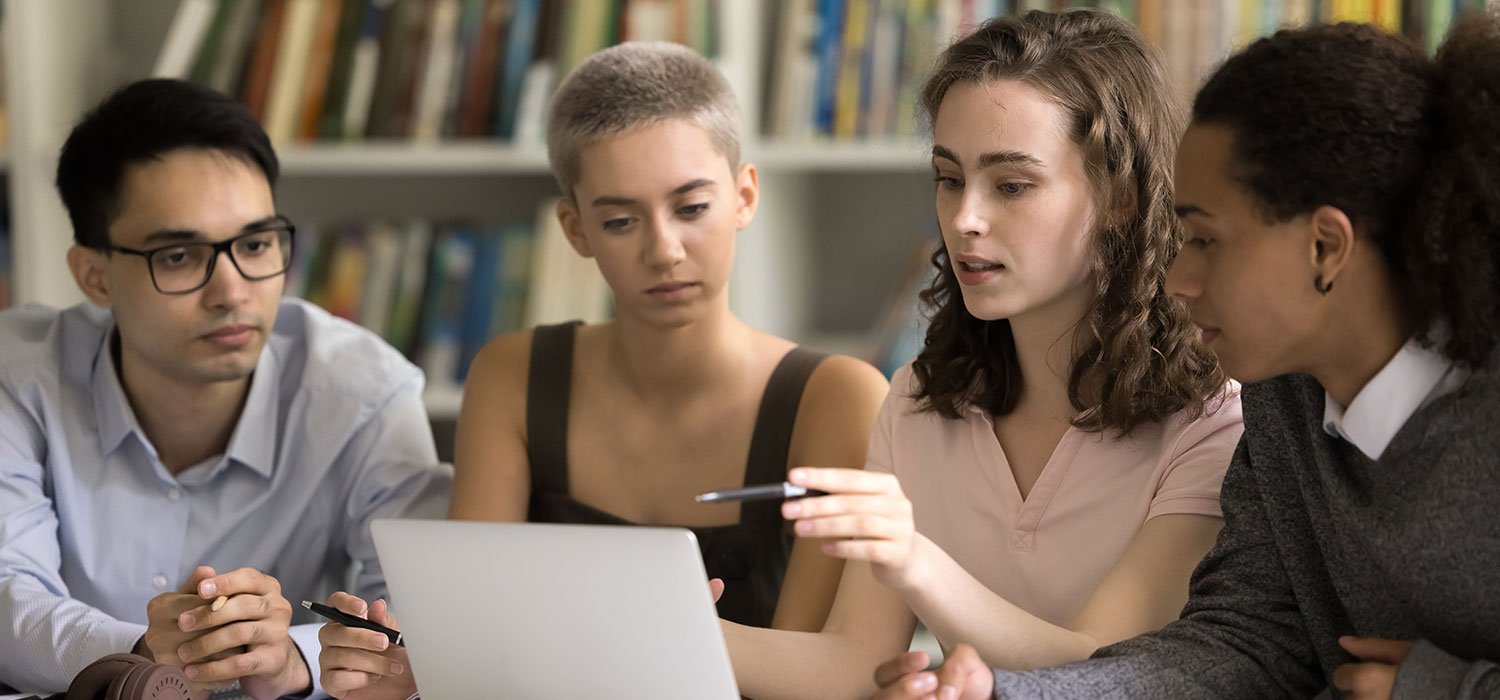
The Jewish Partisan Educational Foundation (JPEF) has produced Foundations of Resistance: A Curriculum to Counter Antisemitism for Grades 6-12 to combat the appalling resurgence of antisemitism in the United States and around the world. Education is our most powerful tool in the fight against antisemitism. Because of this, it falls upon our teachers to form the critical front line against the spread of antisemitism and the threats posed by its escalation. JPEF is committed to producing new and innovative educational resources to support the leadership of teachers in this all-important work.
Overview
This curriculum consists of four classroom lessons that utilize the extraordinary history of the Jewish partisans of World War II as a lens through which to teach students why they should and how they can resist antisemitism and hate, both systemically and in their own lives.
Antisemitism
Antisemitism is generally defined as prejudice against or hatred of Jewish people. However, it may be more usefully understood as a conspiracy theory about how the world operates. Known as “the longest hatred,” antisemitism is based on centuries-old malicious lies and tropes. It is uniquely used as an umbrella explanation for all societal problems, suggesting that Jews are the clandestine operators of the world, acting for their malevolent purposes and gain.
Antisemitism reflects how society chooses to address its problems and challenges. Due to the all-encompassing nature of antisemitism, when people turn to conspiracy theories to explain the causes of society’s problems, Jews are often the first group of people to become scapegoats—but scapegoating rarely ends with the Jewish people.
For example, in recent years, the antisemitic “Great Replacement” conspiracy theory not only incited the White Supremacist mass murder of Jews at the Tree of Life Synagogue in Pittsburgh, but also the mass murder of Black Americans at the Emanuel African Methodist Episcopal Church in Charleston and a supermarket in Buffalo; the mass murder of Latino and Hispanic immigrants at a store in El Paso, and the mass murder of Muslims at the Al Noor Mosque in New Zealand.
As every society faces problems and challenges, the scapegoating of Jews knows no boundaries. It festers in every country, regardless of whether its Jewish population is large, medium, minor, or non-existent. It is beholden to no political party or affiliation and can be found across the political spectrum, though it is more frequently found towards the extremes. It is revealed, often unwittingly, in our workplaces, personal relationships, and by friends and family members.
Antisemitism mutates, uniquely finding its path into every cultural medium. It courses through the internet and social media. It infects popular culture—music, sports, film, TV, and multiplayer gaming. It is propagated by religious institutions, governments, systems of news, colleges and universities, and now, most insidiously, antisemitism has become rampant in our schools.
Indifference
Some of history’s greatest crimes would not have been possible without the inaction of the masses. Driven by ill will and banality, societal indifference played an overarching role in the Holocaust. It was not only the actions of perpetrators but also the inaction of bystanders that were responsible for the horrors unleashed on innocent human beings. Indifference leads to the blind and willful acceptance of falsehoods.
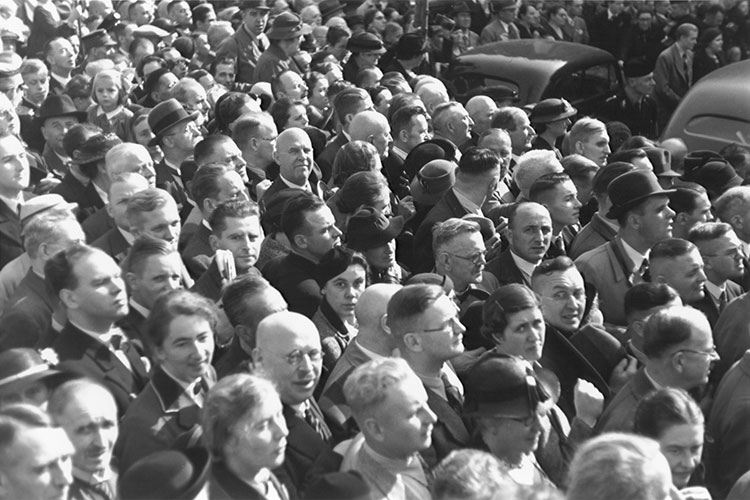
Ignorance
Driven by falsehoods and arrogance, ignorance is the fuel of antisemitism. Antisemitic falsehoods take the form of misinformation, disinformation, and conspiracy theories, often based on centuries-old malicious lies and tropes. These falsehoods, combined with an unwillingness to know and learn, create an environment of ignorance in which social discord and mistrust of Jewish people flourish. Ignorance often leads to narcissistic behavior and imprudence, characterized by poor judgment.

Discord
The horrors of the Holocaust were perpetrated in a time and place of great societal discord, in which the decay of understanding between peoples reached a tipping point. Driven by the narcissism of white supremacy and nationalism, this discord contributed to an atmosphere permissive to societal derangement and lawlessness, leading to the election of Hitler and the rise of Nazi Germany. Characterized by a lack of common empathy, societal discord leads to antisemitic bias and antisocial behavior.
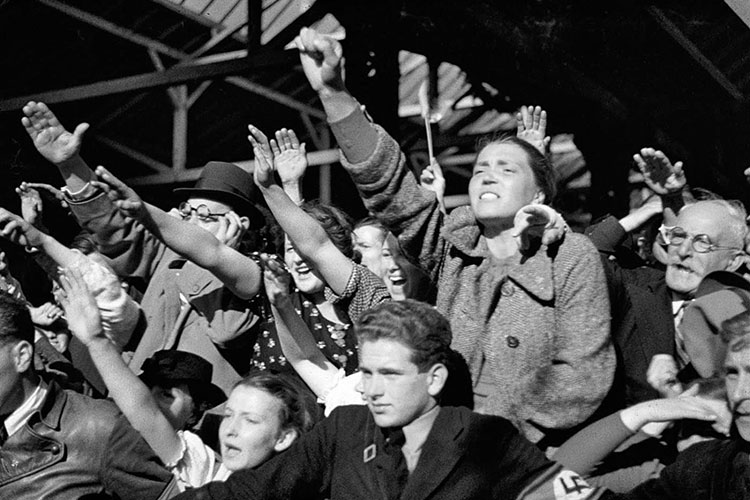
Destruction
Antisemitic behavior erodes the social structures that uphold democracy, including religious institutions, governments, news systems, colleges and universities, and school systems. Antisemitism is driven by bias and is actualized through harassment, violence, cruelty, and other antisocial behaviors, which can lead to complacency in the face of injustice and ill will toward our fellow human beings.
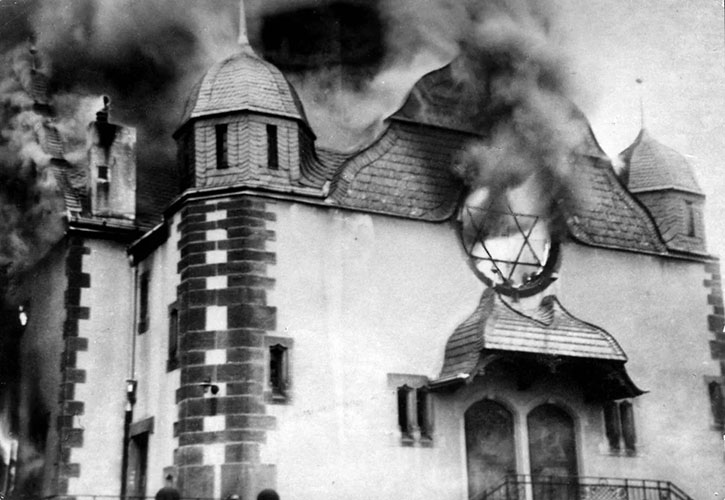
Approach
Foundations of Resistance consists of four classroom lessons that utilize the extraordinary history of the Jewish partisans of World War II to inspire and empower students to resist antisemitism and hate. To accomplish this, the curriculum posits four perpetual goals as foundational to countering antisemitism: CHOOSING, KNOWING, UNDERSTANDING, and BUILDING.
Choosing
Creating a better society
Antisemitism reflects how society chooses to address societal problems. Promoting a society driven by goodwill leads to solving our collective challenges rather than scapegoating specific groups and communities. It is the will to do good that leads to choosing not to be a bystander. As Holocaust scholar Yehuda Bauer puts it, “Thou shalt not be a victim, thou shalt not be a perpetrator, but, above all, thou shalt not be a bystander.”
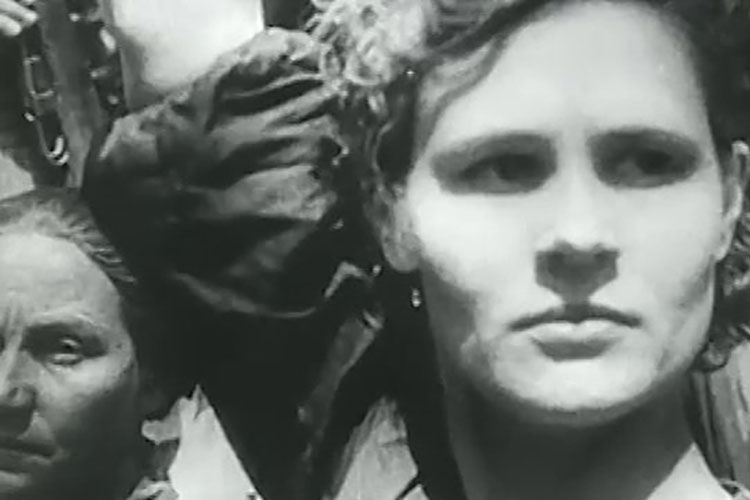
Knowing
Creating a more informed society
Resisting antisemitism requires identifying antisemitism. Based on centuries-old malicious lies and tropes, antisemitic conspiracy theories are uniquely used as “umbrella explanations” for societal problems, suggesting that Jews are the clandestine operators of the world, acting for their malevolent purposes. Gaining the ability to call out antisemitic conspiracy theories by identifying their origins is the next critical step in effectively countering antisemitism. By choosing to create a society that values knowledge and intellectual curiosity, we are more likely to succeed at distinguishing facts from falsehoods, avoiding our baser inclinations to scapegoat others.
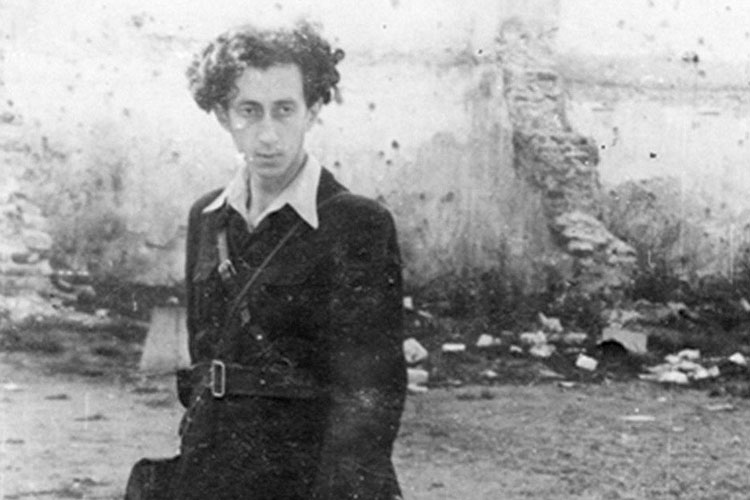
Understanding
Creating a more caring society
When we strive to understand the experiences of others, we recognize their humanity, acknowledging them as unique individuals rather than collective stereotypes. The Jewish partisans lived in a time and place bereft of common empathy, contributing to an atmosphere conducive to societal derangement and the horrors of the Holocaust. By choosing to learn about the experiences of others—their motivations, interactions, and goals—we can cultivate our own empathy, help people feel more understood and less alone, and contribute to a healthier, more caring society.
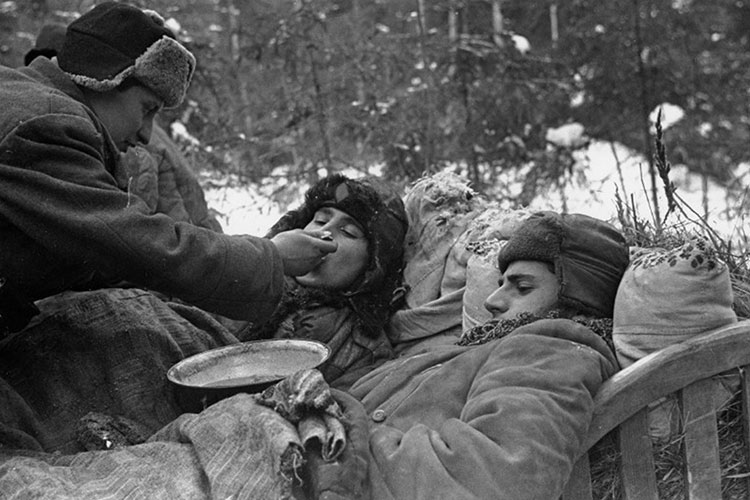
Building
Creating a more just society
Prosocial behavior includes helping, sharing, volunteering, and cooperation. However, these activities can have negative outcomes when they are rooted in biases. This is why knowing and understanding are essential prerequisites to positive social action. By choosing objectivity over personal belief, we are more likely to find effective and ethical solutions to our problems. Positive social action is objective and leads to building a more just society.

Teacher's Guides
Foundations of Resistance lessons can be taught individually, in tandem, in trios, or can be extended into a complete four-lesson unit of study. Each lesson can be completed in a single classroom period, and each is accompanied by a comprehensive Teacher’s Guide.
Teacher-friendly and easy to use
There are four lessons to choose from: one for grades 6-12, one for grades 9-12, and two for grades 10-12
Lessons can be completed in one classroom period (50 minutes)

Selecting a Lesson
Each Foundations lesson can be completed in one 50-minute classroom period/block. Lessons can be utilized across numerous school subject areas, including: Social Studies, History, English, Ethics, Writing, Holocaust Studies, and others.
For Grades 6-8
Understanding the Partisans is the ideal lesson for grades 6-8. The other three Foundations of Resistance lessons require greater maturity and are not intended for these grades.
For Grade 9
Knowing Antisemitism and Understanding the Partisans are both ideal lessons for grade 9. They may be presented as standalone lessons or as a two-lesson unit of study. JPEF recommends conducting Knowing Antisemitism first, followed by Understanding the Partisans.
For Grades 10-12
All four lessons can be used in this grade range. Teachers can use them individually as standalone lessons or combine two, three, or all four for a short unit of study. If selecting multiple lessons, any combination of two, three, or four lessons work together, though we suggest teaching them in the following order: Choosing Leadership, Knowing Antisemitism, Understanding the Partisans, Building Resistance.
Selecting By Subject
Again, if selecting multiple lessons, any combination of two, three, or four lessons work together, though we suggest teaching them in the following order: Choosing Leadership, Knowing Antisemitism, Understanding the Partisans, Building Resistance.
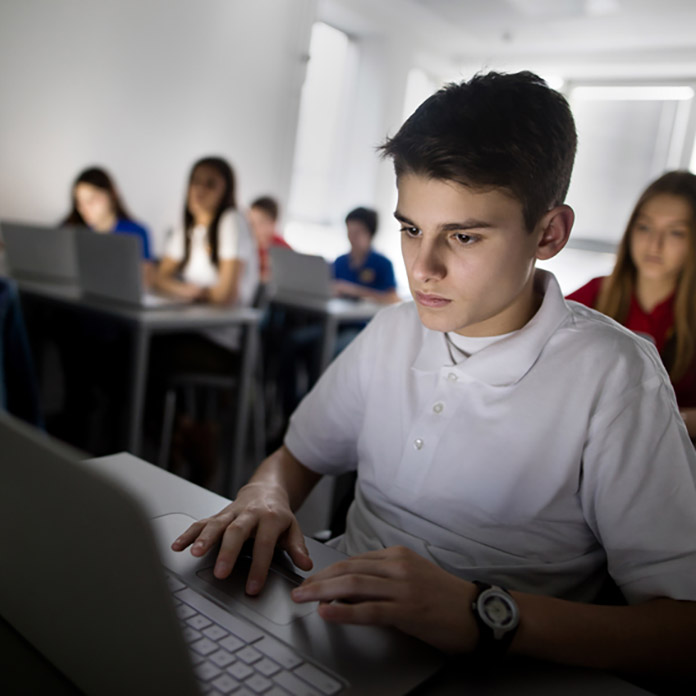
Learning Requirements
Foundations lessons are not intended as an introduction to the subject of the Holocaust. Students require prior learning about the Holocaust in order to contextualize the history of the Jewish partisans and the magnitude of their circumstances.
For meaningful use of Foundations, students should, at minimum, understand the Holocaust was the genocide of European Jews during World War II, in which Nazi Germany and its collaborators systematically murdered six-million Jews.
Each Foundations lesson features a webquest that requires students to have online access. Using Foundations requires in-class use of either a tablet, laptop, or desktop computer. Smart phones are not recommended for webquests.
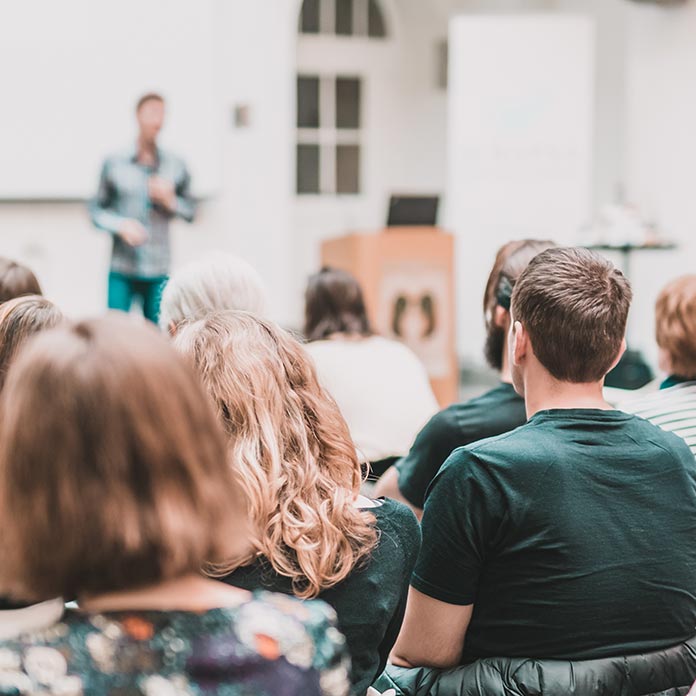
Critical Conversation Guides
For educators looking for extension activities, or those who wish to conduct a shorter, 30-minute classroom activity, Foundations of Resistance offers four Critical Conversation Guides that focus on specific subtopics.
To use these activities, form student discussion pairs or small groups. Have students read each section of the guide individually. At the end of each section, direct students to engage in a critical conversation with their partner or group about what they have read, using the provided discussion questions.
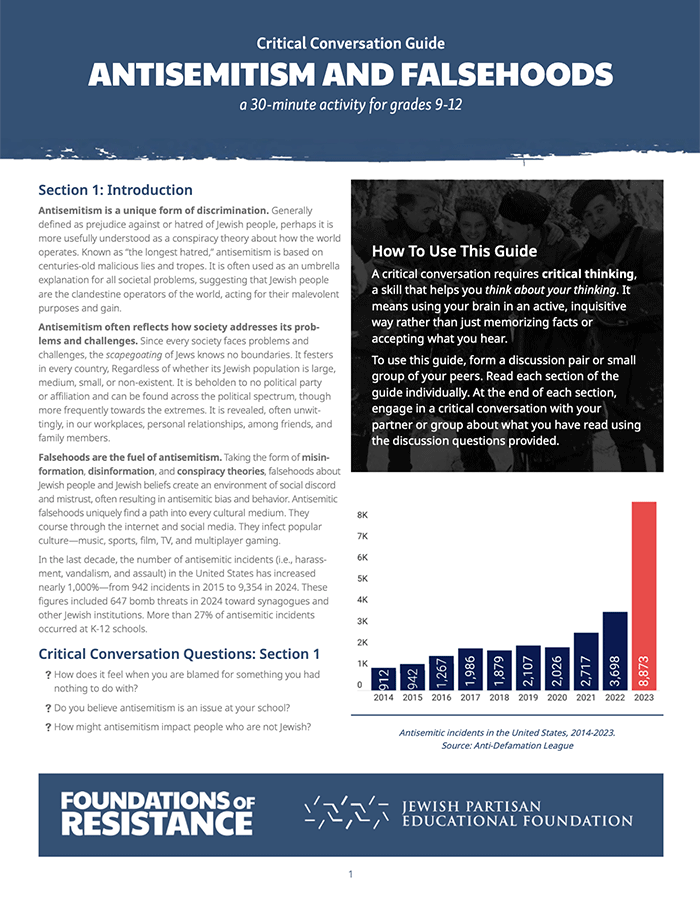
Critical Conversation: Antisemitism and Falsehoods is a 30-minute classroom activity and part of the “Knowing” strand of JPEF’s Foundations of Resistance curriculum. This activity features a study guide on the topic of falsehoods, encompassing misinformation, disinformation, and conspiracy theories. The guide casts falsehoods as the fuel of antisemitism. It illustrates how malicious lies about Jewish people create an environment of social discord and mistrust, which has led to centuries of antisemitic bias and behavior. This guide helps students understand how antisemitism arises from falsehoods, emphasizing and exploring the concepts of digital literacy and digital citizenship.
Download the Guide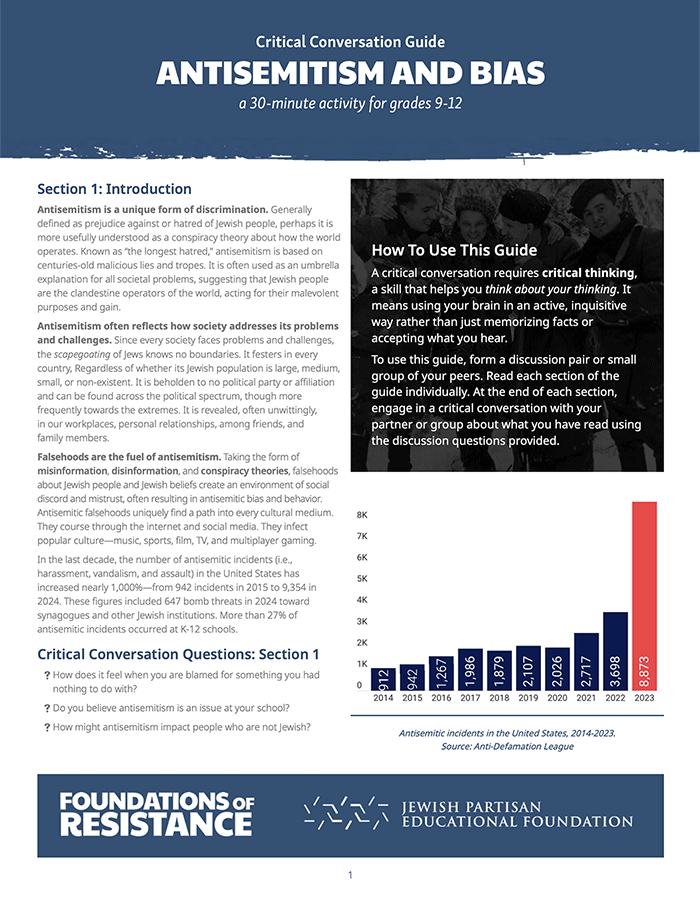
Critical Conversation: Antisemitism and Bias is a 30-minute classroom activity and part of the “Building” strand of JPEF’s Foundations of Resistance curriculum. This activity features a study guide on the topic of antisemitic bias. Taking the form of harassment, violence, cruelty, and other antisocial behaviors, antisemitism is actualized through bias. It can be propagated by social constructs such as religious institutions, governments, news systems, colleges and universities, and school systems. This guide helps students understand how prejudice and discrimination arise from various forms of bias, emphasizing and exploring the importance of objectivity and critical thinking.
Download the GuidePreparing to Teach the Holocaust
The Jewish people have a long history and a rich cultural heritage. It is important to contextualize their experience by showing life before and after the Holocaust. Enable students to appreciate Jews as more than dehumanized and degraded victims of Nazi persecution. Convey to them the enormous loss to humanity and contemporary world culture that resulted from the destruction of vibrant Jewish communities in Europe.
The following suggestions for preparing to teach about the Holocaust and antisemitism represent the latest best practices of leading Holocaust educational organizations, including the International Holocaust Remembrance Alliance (IHRA), the United States Holocaust Memorial Museum (USHMM), and Facing History & Ourselves.

Prepare Your Environment:
Create an open, positive learning environment
The Holocaust can challenge young people's assumptions about society, civilization, and human behavior, potentially triggering negative feelings or reluctance to explore this difficult history. Creating an open and safe learning environment where students have the time and space to reflect, ask questions, and share ideas and opinions is essential for addressing and openly discussing the Holocaust.
Prepare Your Facts:
Avoid legitimizing distortion and denial of the past
Holocaust distortion, defined as “intentional efforts to excuse or minimize the impact of the Holocaust or its principal elements” often involves downplaying the Holocaust’s impact or shifting blame from Nazi Germany and their collaborators. Holocaust denial, as defined by the IHRA, encompasses “discourse and propaganda that deny the historical reality and extent of the extermination of the Jews.” Teachers must avoid inadvertently legitimizing Holocaust deniers by engaging in false debates or providing a platform to treat Holocaust denial as a legitimate historical argument. To counteract such distortion, educators should rely on historical facts supported by primary sources and research literature.
Prepare Your Awareness:
Be responsive to student backgrounds and emotions
Students who feel that the suffering and persecution of groups they identify with have not been adequately addressed may resist learning about the Holocaust and antisemitism. It is important to be sensitive to students’ feelings and opinions, especially regarding issues that personally affect them. Facilitate open discussions on these matters and be ready to explore other factual instances of genocide in the modern world. Differentiate between various cases, including their causes and nature, ensuring that these discussions focus on understanding each issue on its own merits rather than engaging in comparisons of relative suffering.
Prepare Your Language:
Be precise with language and define the Holocaust
Consistently modeling precise terminology is important when teaching the history of the Holocaust. Words that describe human behavior often carry multiple meanings. For example, "resistance" typically suggests a physical act of armed revolt, however, during the Holocaust, resistance could involve willful defiance through the continuation of religious practices when it was dangerous or deadly to do so. Establishing a definition of the Holocaust at the outset provides students with a framework to understand historical events, their impact, and the individuals involved.
Prepare Yourself:
Teaching students about antisemitism requires courage
JPEF believes that teachers are the nation’s front line against the threat of antisemitism and is here to support them. Teaching this topic requires courage, as it involves addressing deep-seated prejudices and uncomfortable truths that can evoke strong emotions. Educators must navigate a challenging landscape of historical and contemporary hatred, striking a balance between sensitivity and firmness to promote constructive dialogue. Despite these challenges, countering antisemitism in middle schools and high schools can be successful if educators stand firm against misinformation and antisemitic rhetoric, promote accurate historical understanding, and maintain a safe, respectful learning environment.
State Standards
Foundations of Resistance aligns with the California Department of Education’s Common Core Standards across Social Studies, English, and History, and is compatible with educational standards across all 50 states.
See Complete StandardsCredits and Acknowledgements
This curriculum's physical and electronic materials are owned, jointly and separately, by the Jewish Partisan Educational Foundation and the JFCS Holocaust Center of San Francisco. This curriculum is free to all, including all California Local Educational Agencies, free of any additional charge, on a perpetual, irrevocable, non-exclusive, royalty free worldwide basis. All curriculum materials may be used together or individually without any permission from JPEF or JFCS, provided that no Party shall sell or attempt to sell, copyright or attempt to copyright, or otherwise profit or attempt to profit from any of the physical and electronic materials.
The intent of this paragraph is to make this curriculum available, free of charge or obstacle, to the public for the benefit of all California public school students and the world.
Foundations of Resistance Team
- Curriculum Director: David Monblatt
- Project Manager/Editor: Sheri Rosenblum
- Website Strategist and Builder: Dario Zadro
- Website and PDF Design: Maeve McCarthy
- Illustrations: Sean Dougherty
- Concept Designs and Wireframes: James Deckinger
- Teacher’s Guides and Additional Wireframes: Kyle Jochai
- Additional Research: Emily Putzke
Choosing Leadership and Understanding the Partisans written by David Monblatt
Knowing Antisemitism and Building Resistance written by Vlad Khaykin and David Monblatt
Critical Conversation Guides written by David Monblatt
Special thanks to the following people for donating their time and insight to review and enhance this curriculum:
Paul Orbuch, Mitch Braff, Nance Adler, Dr. Joshua Andy, Dr. Donald Berry, Linda Johnson, Saul Kaiserman, Amanda Lanceter, Bill Loy, Jamie Rhonheimer, and Hadar Wissotzky.
This curriculum is a project of the California Teachers Collaborative for Holocaust and Genocide Education, established by the JFCS Holocaust Center, with support from the California Department of Education, Marin County Office of Education, and the State of California.
Members of the California Teachers Collaborative include Avenues for Change: Holocaust and Genocide Education, Cambodian Genocide Education Resource Center, Central Valley Holocaust Educators’ Network (CVHEN), Echoes and Reflections, Facing History and Ourselves, The Genocide Education Project: Armenian History and Education, Holocaust Museum LA, Jewish Family and Children’s Services Holocaust Center, the Jewish Partisan Educational Foundation (JPEF), Museum of Tolerance, Redbud Resource Group: Indigenous History and Education, TWIGE Project: Teaching about the Genocides in Rwanda and Guatemala, USC Shoah Foundation for Visual History and Education and Uyghur Genocide Online Resource Center.
